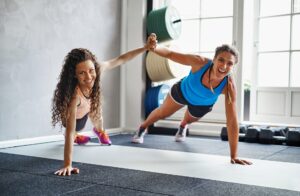Enhance flexibility with beginner yoga poses. These beginner yoga poses can improve flexibility for beginners.
Yoga is a wonderful practice that not only helps in increasing flexibility but also boosts overall well-being. If you are new to yoga and want to improve your flexibility, there are specific poses tailored for beginners that can help you achieve that.
By incorporating these beginner poses into your practice, you can gradually enhance your flexibility and strength, leading to a healthier, more agile body.
We will explore some beginner-friendly yoga poses that focus on stretching and opening up different parts of the body to help improve flexibility.
Whether you are looking to touch your toes or simply want to feel more comfortable in your body, these beginner yoga poses can be a great place to start.
Benefits Of Yoga
Yoga is a powerful practice that offers a multitude of benefits for both the body and mind. Whether you are a beginner or a seasoned practitioner, incorporating yoga into your routine can have a transformative impact on your overall well-being. From improved flexibility to stress relief and cultivating a strong mind-body connection, the benefits of yoga are far-reaching and profound. Let’s explore these benefits in more detail.
Improved Flexibility
Yoga incorporates a range of stretching exercises and poses that are designed to improve flexibility and mobility. These movements help to lengthen and elongate the muscles, reducing stiffness and enhancing overall flexibility. By regularly practicing yoga, individuals can experience increased suppleness in the body, leading to improved posture and reduced risk of injury.
Stress Relief
One of the most widely recognized benefits of yoga is its ability to alleviate stress and promote relaxation. Through a combination of deep breathing techniques, meditation, and mindful movement, yoga helps to release tension and calm the nervous system. As a result, practitioners often experience reduced levels of anxiety and a greater sense of mental clarity and emotional well-being. The stress-relieving effects of yoga can have a profound impact on overall quality of life.
Mind-body Connection
Yoga places a strong emphasis on the connection between the mind and body. Through the practice of asanas (yoga poses) and meditation, individuals can develop a heightened awareness and appreciation for their physical and mental states. This increased mindfulness can lead to greater self-understanding, improved concentration, and a deeper sense of inner balance. By fostering a strong mind-body connection, yoga can support holistic well-being and overall harmony.

Credit: www.pinterest.com
Getting Started With Yoga
Embarking on a yoga journey can be an immensely rewarding experience for individuals seeking to enhance their flexibility and overall well-being. As a beginner, it’s important to start off on the right foot by considering certain essential factors that will pave the way for a fruitful yoga practice. Let’s delve into the initial steps to take when getting started with yoga.
Choosing The Right Class
As a beginner, selecting the appropriate yoga class is crucial. Opt for beginner-friendly and introductory classes that cater to individuals who are new to the practice. These classes are tailored to provide a solid foundation and comprehensible instructions to help you ease into the practice gracefully.
Essential Props For Beginners
When delving into the world of yoga, it’s important to equip yourself with the essential props that will support and aid your practice. Invest in a quality yoga mat to provide comfort and stability during various asanas. Additionally, props such as blocks, straps, and bolsters can assist in achieving proper alignment and enhancing flexibility, especially for beginners. Ensuring you have these tools at your disposal sets the stage for a more enjoyable and effective yoga journey.
Setting Realistic Goals
Before delving into yoga, it’s essential to establish realistic goals to frame your practice. Be mindful of your current physical abilities and set goals that are attainable within a reasonable timeframe. Whether it’s aiming to touch your toes with greater ease or improving your overall flexibility, having clear and achievable aspirations will keep you motivated and committed to your practice.
Yoga Poses For Flexibility
Enhance your flexibility with these beginner-friendly yoga poses designed to improve your range of motion and increase your overall flexibility. Practice these poses regularly to experience the benefits of increased flexibility in your body and mind.
Yoga Poses for Flexibility Flexibility is a crucial aspect of physical well-being. With regular practice, yoga can greatly enhance your flexibility, allowing you to move with ease and grace. Whether you’re a beginner or have some experience, incorporating specific yoga poses into your routine can help loosen tight muscles and improve your overall flexibility. In this article, we will explore five essential yoga poses that are perfect for beginners looking to enhance their flexibility: Mountain Pose, Child’s Pose, Downward-Facing Dog, Triangle Pose, and Forward Fold.
Mountain Pose
The Mountain Pose, also known as Tadasana, is the foundation of all standing poses. Stand tall with your feet hip-distance apart, toes pointing forward. Distribute your weight evenly on all four corners of your feet. Engage your leg muscles, lengthen your spine, and roll your shoulders back. Keep your chin parallel to the floor and gaze straight ahead. This pose helps to improve posture and increases body awareness.
Child’s Pose
Child’s Pose, or Balasana, is a resting pose that stretches the back and shoulders. Begin by kneeling on your mat, toes touching and knees hip-width apart. Sit back on your heels and exhale as you lower your torso between your thighs. Extend your arms forward or alongside your body, resting them on the mat. Let your forehead rest on the floor and relax your entire body. This pose releases tension in the back, hips, and neck, promoting deep relaxation.
Downward-facing Dog
The Downward-Facing Dog, or Adho Mukha Svanasana, is a rejuvenating pose that stretches and strengthens the entire body. Start on your hands and knees, with your wrists aligned under your shoulders and knees under your hips. Exhale and lift your knees away from the floor, gradually straightening your legs. Align your heels with the floor and keep your head between your upper arms. Press your hands into the mat, lengthen your spine, and engage your core. This pose stretches the hamstrings, shoulders, and calves, as well as lengthens and decompresses the spine.
Triangle Pose
The Triangle Pose, or Trikonasana, is a standing pose that stretches and strengthens the legs, hips, and side body. Begin with your feet wide apart, right foot turned out and left foot slightly turned in. Extend your arms parallel to the floor, palms facing down. Shift your hips to the left and extend your torso to the right, keeping both legs straight. Lower your right hand to your shin, ankle, or the floor, and reach your left arm towards the sky. Gaze up or forward, depending on your comfort level. This pose improves spinal mobility and provides a deep stretch for the hamstrings and hips.
Forward Fold
The Forward Fold, or Uttanasana, is a gentle inversion that stretches the entire back body, promoting flexibility in the hamstrings and back. Stand with your feet hip-distance apart and fold forward from the hips as you exhale. Bend your knees as much as needed to bring your chest closer to your thighs. Let your head and neck relax, and grab onto opposite elbows if desired. Feel the stretch in your hamstrings as you allow your upper body to hang heavy. This pose calms the nervous system and relieves stress. By incorporating these yoga poses into your routine, you can gradually improve your flexibility and experience the benefits of a more limber body. Remember to always listen to your body and practice within your limits. Regular practice of these poses will not only enhance your flexibility but also bring a sense of calm and relaxation to your mind and spirit.

Credit: www.pinterest.com
Building Strength With Yoga
Building strength is a crucial aspect of yoga practice, as it helps to improve overall physical fitness and enhances flexibility. Incorporating specific yoga poses can increase muscle tone, endurance, and stability. By focusing on strength-building poses, beginners can gradually improve their flexibility and develop a strong foundation for their yoga journey.
Warrior I Pose
Warrior I Pose, also known as Virabhadrasana I, is an excellent yoga pose for building strength in the lower body. To perform this pose, begin by standing with your feet hip-width apart. Step your right foot forward, ensuring that your back foot is facing slightly outward. Bend your front knee and extend your arms overhead, keeping your palms facing each other. Engage your leg muscles, grounding through the feet, and feel the strength building in your legs and core.
Bridge Pose
Bridge Pose, or Setu Bandhasana, is a powerful pose that strengthens the back, glutes, and hamstrings. Lie on your back with your knees bent and feet resting flat on the floor, hip-width apart. Place your arms alongside your body with the palms facing down. Press your feet into the ground, engaging your glutes, and lift your hips as high as possible while keeping your shoulders relaxed. Stay in this pose for a few breaths, feeling the strength building in your lower body.
Plank Pose
Plank Pose, also called Phalakasana, is a great full-body strength-building pose that targets the core, arms, shoulders, and legs. Start in a push-up position with your hands directly under your shoulders. Engage your core, align your body in a straight line from head to heels, and hold this position for as long as comfortable. Feel the strength building in your entire body as you maintain this pose, focusing on your breathing.
Chair Pose
Chair Pose, or Utkatasana, is a challenging pose that strengthens the thighs, hips, and glutes. Begin by standing with your feet together. Inhale and raise your arms overhead, palms facing each other. Exhale and bend your knees, as if sitting back into an imaginary chair. Engage your core, keep your back straight, and shift your weight toward your heels. Feel the strength building in your lower body as you hold this pose for several breaths.
Tree Pose
Tree Pose, also known as Vrikshasana, is a balancing pose that strengthens the legs and improves stability. Start by standing tall with your feet together. Shift your weight to your left foot and bring the sole of your right foot onto your left inner thigh. Make sure to avoid placing your foot directly on the knee. Find your balance, and when ready, raise your arms overhead, palms facing each other. Feel the strength building in your standing leg as you focus on your breath and maintain the pose. Switch sides and repeat.

Credit: www.amazon.com
Frequently Asked Questions Of Yoga Poses For Beginners To Enhance Flexibility
Does Yoga Increase Flexibility For Beginners?
Yes, yoga increases flexibility for beginners by gently stretching and strengthening muscles, joints, and ligaments. Regular practice can gradually improve range of motion and posture.
What Is The Best Yoga Pose For Flexibility?
The best yoga pose for flexibility is the Downward Dog. It stretches the entire body and increases flexibility. This pose also strengthens the arms, shoulders, and back. Practice this pose regularly for improved flexibility.
How Do I Start Yoga If I Am Not Flexible?
To start yoga with limited flexibility, begin with gentle and beginner-friendly poses. Focus on breathing and gradual progress, listening to your body. Seek out beginner classes or online videos tailored for less flexible individuals. Patience and consistency will yield improvement over time.
How Long Does It Take To Improve Flexibility With Yoga?
Yoga can improve flexibility over time, but the duration varies for each individual. Consistent practice and proper alignment can lead to noticeable improvements in flexibility within a few weeks or months. However, continued practice is necessary to maintain and further enhance flexibility.
Conclusion
To wrap up, incorporating yoga poses into your routine is a great way for beginners to improve their flexibility. By consistently practicing these poses, you can gradually increase your range of motion and enhance your overall physical well-being. Remember to start with basic poses and gradually progress as your body becomes more comfortable.
So, roll out your mat and embark on this journey of flexibility and self-discovery with yoga.






